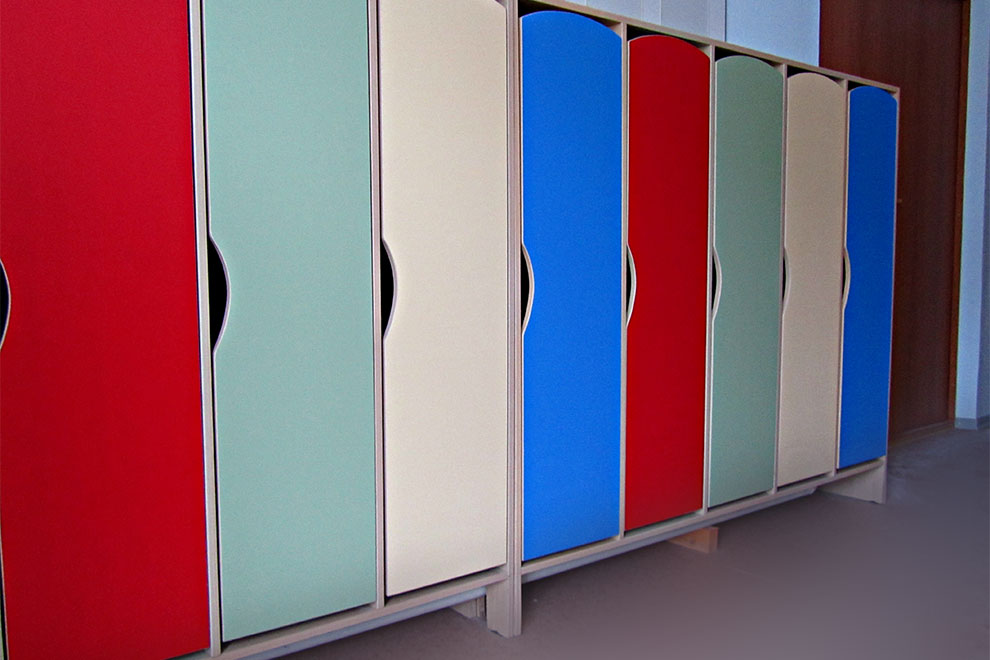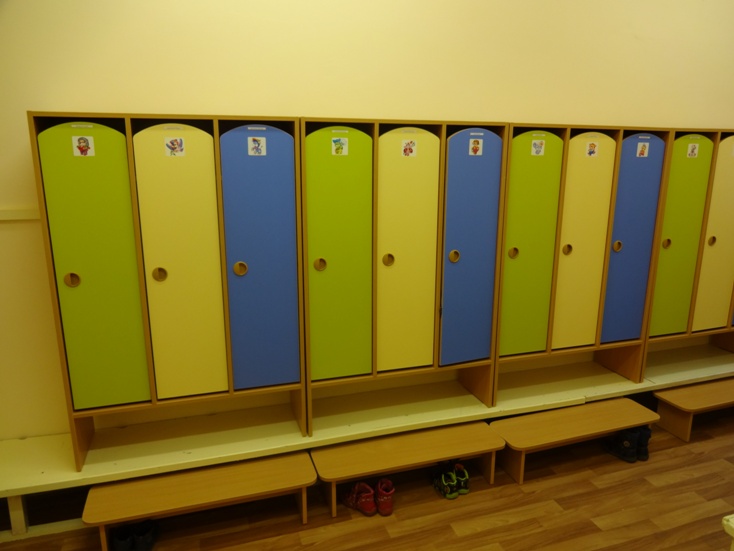Features of lockers for kindergartens, the nuances of choice

To make it comfortable for the kids to change clothes, the locker room has lockers for kindergarten, which are manufactured according to sanitary standards and are made in a suitable design. There are many varieties of lockers. If your parents decide to replace the locker room furniture in the kindergarten, you should familiarize yourself with the options and choose the best one.
Content
What are
By appointment, lockers in kindergarten are divided into several groups:
- storage of pots;
- hanging towels;
- clothes and replaceable shoes.
Each is installed in a certain way. A wardrobe is located in the hallway or dressing room. So children are more comfortable to leave things and do not have to carry them with them. Often, a wardrobe is equipped with a special recess or does not reach the floor with a door. So children can put the seat back there. If the locker rooms are small, this is a great way to make them more comfortable.
Given the size of the cabinets can be:
- single-tier;
- two-tier.
To save space, produce two-tier children's closets for storing towels. Each compartment has a hook where the child hangs up his accessories. A two-level locker saves space, allowing each baby to have a private place.
A cupboard for towels is often made integrated - there are from 2 to 5 sections. Thus, it is possible to add stability designs and weights, preventing furniture from falling on the kids. A wardrobe can be combined. But each child has a personal door and a shelf; hygiene rules for such furniture are observed.
In kindergarten, specializing as a nursery, additionally requires the installation of a cabinet for pots. It is located in the toilet room and differs from other furniture in that its dimensions may not correspond to the height of the child, since adults, not children, get the pots from such cabinets.
Appointment
Most children stay in the kindergarten all day, so they need a place to store their belongings. In the lockers for clothes, the kids put in replaceable shoes, physical education, spare tights, socks and T-shirts. They also hang a towel that is used for washing.
In some kindergartens, things are stacked on chairs for a walk or charge. This is inconvenient, they can hurt and drop. It is worth taking care of the presence of the baby's furniture for storing things.
Some groups have enough footage to make each baby a separate cupboard for towels. This increases the level of hygiene of the child, since clothes after the street and clean accessories are stored in different places.
Where a towel rack for each of the children cannot be made, it is often common. The child is allocated a separate shelf where he stores his belongings.Such a towel rack is considered a less hygienic way to place accessories than an individual one.
Design Topics
Cabinets for kindergarten are often made unpainted or with evenly distributed color on all doors. This is to prevent children from quarreling because of the color of the cabinet or its design. But the wardrobe should belong to one child, which means it must be marked. This is done by marking the door. Marking on cabinets is done with a paint or sticker. It can be of various types:
- color;
- animals;
- Pictures
- in numbers.
It is undesirable to use inscriptions as markings on the locker, since not all children can read at the age of the kindergarten. If the group is senior or preparatory, you can put numbers on the doors. But before that you need to make sure that all children know them and will not be confused.
To make wardrobes more beautiful for children, it is advisable to use pictures as tags. Each child remembers which designation corresponds to his door. Inside the locker room, in a place visible to the parents, a sign is posted showing the symbol of each baby. It can be the simplest geometric shapes - stars, triangles, squares, and so on, if the group is middle-aged. For babies, it is preferable to use animal images as tags. So the child can always find his closet for clothes and distinguish it from strangers.
Stickers with your favorite characters from fairy tales or cartoons are suitable as colorful design. Each child can independently choose with the parents the image of the sign on the locker. It must be remembered that the design of furniture should be appropriate for the age of the children.
Color spectrum
In the design of children's furniture for educational institutions, the most neutral colors are used. This is done so as not to overload the visual analyzers of babies. Therefore, the decoration of the furniture should be calm, only bright accents on the cabinets in the form of an asterisk, animal or other symbol denoting belonging to a particular child are allowed.
Preschool mode implies some educational program. If you use colorful furniture decoration inside kindergartens, the child will not absorb information, being distracted by bright spots. But since the group and the locker room are often separated, these requirements can be mitigated for the children's wardrobe. Sometimes the decoration of furniture in this area is quite bright. This is done so that coming to kindergarten is a festive event, and not an everyday routine for children.
When staining furniture, they try not to use gloomy and dark colors. To develop a craving for beauty in children, shades should combine well with each other. But it is better to paint the cabinets in bed colors. This will add peace to restless babies.
Requirements for Children's Furniture
The design of lockers is not regulated. This moment remains at the discretion of the administration of kindergartens and parents. But children's furniture must meet certain requirements. This list includes:
- use of non-toxic materials (ideally - processed wood);
- compliance with the sizes of the child’s age (furniture suitable for the average height is purchased in the group)
- lack of sharp corners, ledges;
- use of quality coating.
The cabinet for towels should be made of moisture-resistant material, because water often pours in the place of its installation. It’s prudent to use templates as affiliation notes. This will help to standardize the drawings and prevent quarrels between children. It is better to use patterns of equal size so as not to create conflicts on this basis. A larger star will appeal to more children than a small one. This will provoke a dispute that will have to be resolved by educators and parents.
Lists of requirements are not limited to those listed, each parent is able to add something from them. These standards will be advisory in nature.The requirements from the list above are considered mandatory, as they ensure the safety of children. And they also help to avoid disputes, whose star on the locker is brighter and better. After all, maintaining a friendly atmosphere in the children's team is the main task of adults.
Video





































